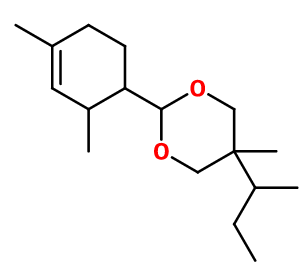
Photo credits: ScenTree SAS
Karanal®
Amber Dioxane® ; 5-butan-2-yl-2-(2,4-dimethyl-1-cyclohex-3-enyl)-5-methyl-1,3-dioxane ; 2-dimethyl cyclohexenyl-5-methyl-5-methyl propyl-1,3-dioxane ; 2-(2,4-dimethyl-3-cyclohexen-1-yl)-5-methyl-5-(1-methylpropyl)-1,3-dioxane ; Karanaorg

Photo credits: ScenTree SAS
| Company | Ingredient Name | ID | Comments | Naturality | Certifications | Purity | Latin name | Treated part | Geographical origin | MOQ |
|---|---|---|---|---|---|---|---|---|---|---|
|
|
Karanal - 30 Gr | - |
Visit website
|
- | - | - | - | - | - |
General Presentation
-
CAS N° : 117933-89-8
-
EINECS number : 413-720-9
-
FEMA number : Donnée indisponible.
-
FLAVIS number : Donnée indisponible.
-
JECFA number : Donnée indisponible.
-
Appearance : Colorless liquid
-
Density : 0,963
-
Volatility : Base
-
Price Range : €€€
Physico-chemical properties
-
Molecular formula : C17H30O2
-
Molecular Weight : 266,42 g/mol
-
Log P : 6,5
-
Fusion Point : -50°C
-
Boiling Point : 300°C
-
Detection Threshold : 2,75 ng/l air
-
Optical rotation : Donnée indisponible
-
Vapor pressure : Donnée indisponible
-
Refractive Index @20°C : Donnée indisponible
-
Acid Value : Donnée indisponible.
-
Flash Point : 104°C
Uses
Uses in perfumery :
Karanal® is used in men's fragrances for woody notes, often in combination with Cedramber®, Iso E Super® or Vertofix®.
Year of discovery :
Discovered in 1987.
Natural availability :
Karanal® is not available in its natural state.
Isomerism :
Karanal® has several asymmetric carbons. No distinction of isomers is made in perfumery: Karanal® refers to their mixture.
Synthesis precursor :
Karanal® is not a precursor to the synthesis of another compound of olfactory interest.
Synthesis route :
Karanal® is synthesized by acetalization of 2,4-dimethyl-3-cyclohexenal by the diol corresponding to the other part of the final molecule.
Regulations & IFRA
Allergens :
This ingredient does not contain any allergen.
IFRA 51th :
This ingredient is not restricted for the 51th amendment

